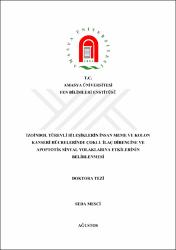| dc.description.abstract | Meme kanseri kadınlar arasında en yaygın görülen kanser türüdür ve dünya çapında tüm kanserlerin yaklaşık dörtte birini oluşturmaktadır. Kolon kanseri ise erkeklerde ve kadınlarda en çok rastlanan kanser türüdür. Bu kanserlerin tedavi yöntemlerinde karşılaşılan en önemli sorunlar hücrelerin sitotoksik etkenler ile ilaca karşı direnç geliştirmeleri ve apoptozun baskılanmasıdır. Bu çalışmada, kanser hücrelerinde proapoptotik ve antikanserojen etki göstereceği düşünülen heterohalkalı bileşiklerin MCF-7 ve DLD-1 hücrelerinde çoklu ilaç direncine (MDR) ve apoptotik sinyal yolaklarına etkilerinin araştırılması amaçlanmıştır. Heterohalkalı bileşiklerin antioksidan aktiviteleri serbest radikal süpürücü, indirgeyici ve metal şelatlama yöntemleri kullanılarak belirlenmiştir. MCF-7 (meme kanseri), MCF-12A (normal meme epiteli), DLD-1 (kolon kanseri) ve CCD-18Co (normal kolon epiteli) hücre hatlarında, bileşiklerin sitotoksik dozu ve IC50 değeri MTT yöntemiyle; hücre canlılığına etkisi gerçek zamanlı hücre analizi sistemi (RTCA) ile belirlenmiştir. IC50 değeri belirlenen bileşiklerin belirtilen hücre hatlarında; anti-karsinojenik etkileri çoklu ilaç direncinde rol oynayan genler ve apoptotik hücre ölümünde önemli rol oynayan genlerin mRNA düzeyleri Real Time-PCR yöntemiyle tespit edilmiştir. Ayrıca apoptoz ve ilişkili sinyal yolaklarında yer alan proteinlerin miktarları membran ilişkili protein array kit ile ölçülmüştür. Heterohalkalı bileşikler yüksek antioksidan aktiviteye sahiptirler ve IC50 değerleri serbest radikal süpürücü (DPPH) yöntem ile 98-108 µg / mL ve metal şelatlama yöntemi ile 21-35 µg / mL olarak tespit edilmiştir. Bileşiklerin MCF-7 ve DLD-1 hücrelerinde antiproliferatif ve sitotoksik etkiye sahip olduğu gözlenmiş ve IC50 değerleri 25-100 µM arasında tespit edilmiştir. Bileşikler çoklu ilaç direnci (ABCB1, ABCC10, ABCC11 ve ABCG2) genlerinin ifadelerinde anlamlı bir azalış, apoptotik hücre ölümü (p53, BAX ve CASP3) genlerinin ifadelerinde anlamlı bir artış ve BCL2, PARP, HSP27, HSP40, HSP60, HSP70 ve HSP90 genlerinin ifadelerinde anlamlı bir azalış göstermiştir. Ayrıca bileşiklerin apoptoz ve ilişkili sinyal yolaklarında yer alan proteinlerin ifadelerinde anlamlı bir sonuç verdiği ve hücreleri apoptoza yönlendirdiği belirlenmiştir. Bileşiklerin MCF-7 ve DLD-1 hücrelerinde çoklu ilaç direncini baskılama yeteneğine sahip ve apoptozun indüklenmesini artıran yeni bir ilaç adayı olabileceği düşünülmektedir. | en_US |
| dc.description.abstract | Heterocyclic compounds, constituting an important class of organic chemistry, are compounds with known anticarcinogenic, anti-inflammatory, antiviral and antiallergic properties that can be easily derivatized with other drug active compounds. According to the literature reviews, although there are many studies on the application of heterocyclic compounds in different disciplines, biological activity studies related to different derivatives of this compound are rare. Cancer disease is expressed as unregulated DNA replicating itself and cell division. Today, it is one of the most important health problems and different methods are used for its treatment (surgical intervention, chemotherapy, immunotherapy, gene therapy, radiotherapy and photodynamic therapy, etc.). New treatment strategies are needed because effective treatment methods are not sufficient for cancer types while developing anticarcinogenic drugs. In this study; In MCF-7 (breast cancer), MCF-12A (normal breast epithelium) and DLD-1 (colon cancer), CCD-18Co (normal colon epithelium) cell lines, the cytotoxic dose and IC50 value of heterocyclic compounds were determined by MTT method; The effect on cell viability will be determined by the real-time cell analysis system (RTCA). In the indicated cell lines of the compounds whose IC50 values were determined; The effect of cell cycle and apoptosis will be evaluated by flow cytometry method depending on the concentration and time (PI staining and AnnexinV / PI dual staining). After determining the presence of apoptosis, it is aimed to perform gene and protein expression analyzes that are involved in signal pathways to be associated with apoptosis. The anti-carcinogenic effects of heterocyclic compounds, the mRNA levels of the pump proteins ABCB1 (MDR1-P-gp), ABCC3 (MRP3), ABCC10 (MRP7), ABCC11 (MRP8) and ABCG2 (BCRP), which play an important role in chemotherapy resistance, were determined by RT-PCR method. It will be. In addition, proteins involved in apoptosis and related signaling pathways; BAD, BAX, BCL2, BCL2L11, BCL2L2, BID, BIRC3, BIRC5, BIRC7, CASP3, CASP8, CD40, CD40LG, CDKN1A, CDKN1B, CYCS, DIABLO, FAS, FASLG, HSPA14, HSPA4, HSPB1, HTRA2 IGF2, IGFBP1, IGFBP2, IGFBP3, IGFBP4, IGFBP5, IGFBP6, LTA, TNF, TNFRSF10A, TNFRSF10B, TNFRSF10C, TNFRSF10D, TNFRSF1A, TNFRSF1B, TNFRSF21, TNFRSF1B, AKTRSF21, TNFRSF1B, The quantities of EIF2A, MAP3K7, MAPK1, MAPK3, MAPK8, NFKBIA, PARP1, PSMD9, REL-A, SMAD2 will be measured with the membrane-associated protein array kit. | en_US |


















